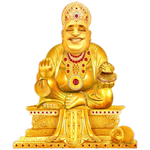Kubera And Lord Venkateswara
The exact origins of the name Kubera are unknown. “Kubera” or “Kuvera” as spelt in later Sanskrit, means “deformed or monstrous” or “ill-shaped one”; indicating his deformities. Another theory suggests that Kubera may be derived from the verb root kumba, meaning to conceal. Kuvera is also split as ku (earth), and vira (hero).
As the son of Vishrava (“Fame”), Kubera is called Vaisravana (in the Pali language, Vessavana) and as the son of Ilavila, Ailavila. Vaisravana is sometimes translated as the “Son of Fame”. The Sutta Nitapa commentary says that Vaisravana is derived from a name of Kubera's kingdom, Visana. Once, Kubera looked at Shiva and his wife Parvati with jealousy, so he lost one of his eyes. Parvati also turned this deformed eye yellow. So, Kubera gained the name Ekaksipingala (“one who has one yellow eye”). He is also called Bhutesha (“Lord of spirits”) like Shiva. Kubera usually is drawn by spirits or men (nara), so is called Nara-vahana, one whose vahana (mount) is nara. Hopkins interprets naras as being water-spirits, although Mani translates nara as men. Kubera also rides the elephant called Sarvabhauma as a loka-pala. His garden is named Chaitrarath.
Kubera also enjoys the titles “king of the whole world”, “king of kings” (Rajaraja), “Lord of wealth” (Dhanadhipati) and “giver of wealth” (Dhanada). His titles are sometimes related to his subjects: “king of Yakshas” (Yaksharajan), “Lord of Rakshasas” (Rakshasadhipati), “Lord of Guhyakas” (Guhyakadhipa), “king of Kinnaras”(Kinnararaja), “king of animals resembling men” (Mayuraja), and “king of men” (Nararaja). Kubera is also called Guhyadhipa (“Lord of the hidden”). The Atharvaveda calls him the “god of hiding”.
Lord Kubera is the 'treasurer of the gods' and 'king of Yaksha'. He is a true representation of wealth, prosperity and glory. Lord Kubera not only distributes, but also maintains and guards all the treasures of this universe. Hence, he is also known as guardian of wealth.
The exact origins of the name Kubera are unknown. "Kubera" or "Kuvera" as spelt in later Sanskrit, means "deformed or monstrous" or "ill-shaped one"; indicating his deformities. Another theory suggests that Kubera may be derived from the verb root kumba, meaning to conceal. Kuvera is also split as ku (earth), and vira (hero).
As the son of Vishrava ("Fame"), Kubera is called Vaisravana (in the Pali language, Vessavana) and as the son of Ilavila, Ailavila.[11] Vaisravana is sometimes translated as the "Son of Fame". The Sutta Nitapa commentary says that Vaisravana is derived from a name of Kubera's kingdom, Visana.[10] Once, Kubera looked at Shiva and his wife Parvati with jealousy, so he lost one of his eyes. Parvati also turned this deformed eye yellow. So, Kubera gained the name Ekaksipingala ("one who has one yellow eye"). He is also called Bhutesha ("Lord of spirits") like Shiva. Kubera usually is drawn by spirits or men (nara), so is called Nara-vahana, one whose vahana (mount) is nara. Hopkins interprets naras as being water-spirits, although Mani translates nara as men.Kubera also rides the elephant called Sarvabhauma as a loka-pala. His garden is named Chaitrarath.
Kubera also enjoys the titles "king of the whole world", "king of kings" (Rajaraja), "Lord of wealth" (Dhanadhipati) and "giver of wealth" (Dhanada). His titles are sometimes related to his subjects: "king of Yakshas" (Yaksharajan), "Lord of Rakshasas" (Rakshasadhipati), "Lord of Guhyakas" (Guhyakadhipa), "king of Kinnaras"(Kinnararaja), "king of animals resembling men" (Mayuraja), and "king of men" (Nararaja).Kubera is also called Guhyadhipa ("Lord of the hidden"). The Atharvaveda calls him the "god of hiding".
Lord Kubera is the 'treasurer of the gods' and 'king of Yaksha'. He is a true representation of wealth, prosperity and glory. Lord Kubera, also known as Kuber, Kuvera and Dhanpati, is worshipped as the God of Wealth by Hindus. Kubera is one god that all the three religions of India namely Hinduism, Buddhism, Jainism all claim to be their own.




